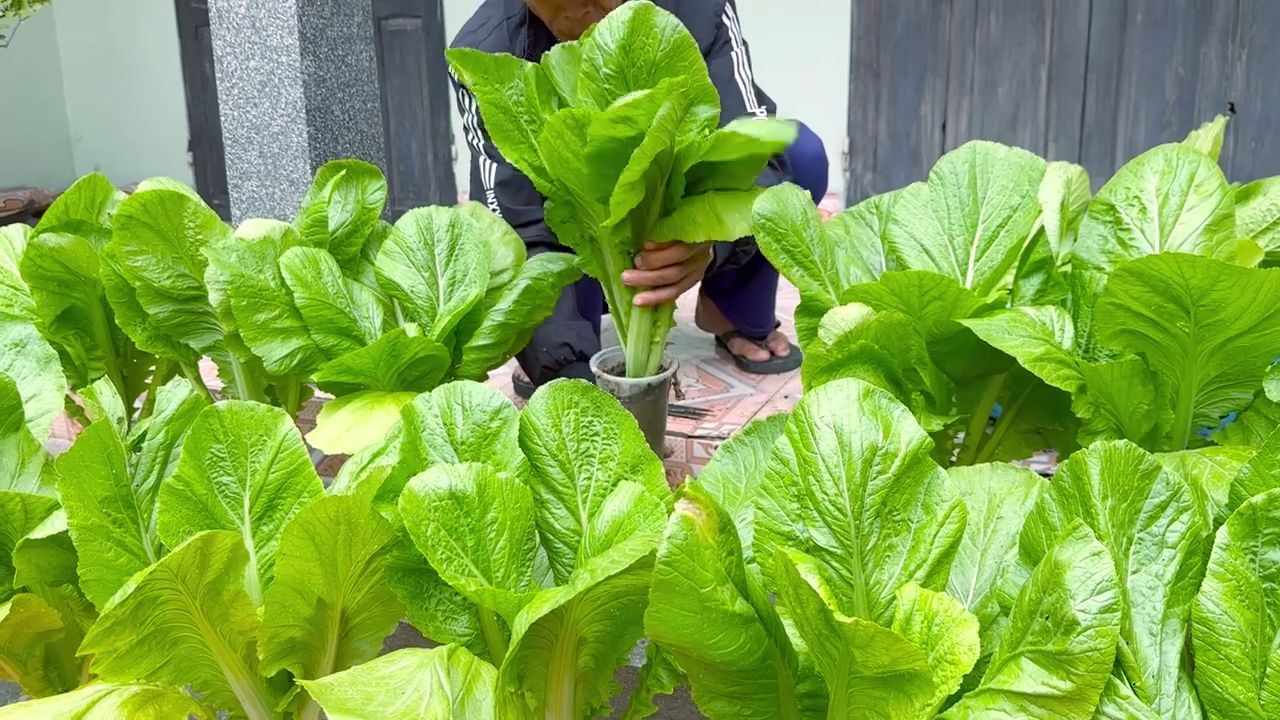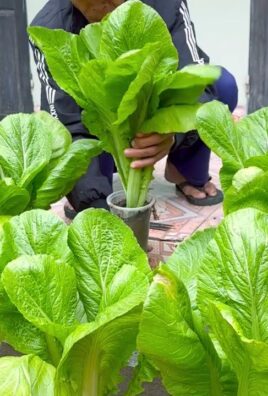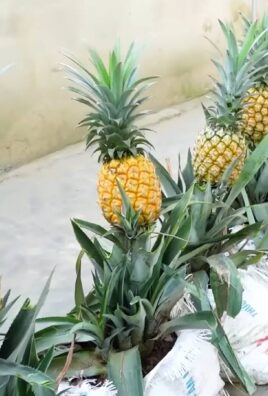Grow veggies indoors? Absolutely! Imagine plucking a ripe tomato or snipping fresh basil right from your kitchen windowsill, even in the dead of winter. Sounds like a dream, right? Well, it doesn’t have to be! For centuries, people have cultivated small gardens indoors, from the ancient Egyptians growing herbs in pots to the Victorian era’s fascination with parlor palms.
But let’s be honest, in today’s busy world, who has time for complicated gardening rituals? That’s where these DIY tricks and hacks come in. I’m going to share some simple, effective methods to help you grow veggies indoors successfully, regardless of your experience level or the size of your space.
Whether you’re a seasoned gardener looking to extend your growing season or a complete newbie eager to try something new, this article is packed with practical tips and easy-to-follow instructions. We’ll cover everything from choosing the right containers and soil to providing adequate light and water. Get ready to transform your home into a thriving indoor garden and enjoy the satisfaction of harvesting your own delicious, homegrown produce!

Growing Your Own Indoor Vegetable Garden: A Beginner’s Guide
Hey there, fellow plant enthusiasts! Ever dreamed of having fresh veggies right at your fingertips, no matter the season? Well, you’re in the right place! I’m going to walk you through setting up your very own indoor vegetable garden. It’s easier than you think, and the rewards are incredibly delicious. Let’s get started!
Choosing the Right Vegetables
First things first, not all vegetables thrive indoors. We need to pick varieties that are happy with less sunlight and confined spaces. Here are some of my favorites, and why they work well:
* Leafy Greens (Lettuce, Spinach, Kale): These are fast-growing and don’t need intense sunlight. Plus, you can harvest leaves as you need them, making them super convenient.
* Herbs (Basil, Mint, Chives, Parsley): Herbs are practically made for indoor growing! They add amazing flavor to your meals and are relatively low-maintenance.
* Peppers (Especially smaller varieties like chili peppers): Peppers can be a bit more demanding, but with the right light, they’ll reward you with colorful and spicy goodness.
* Tomatoes (Dwarf or Bush varieties): Forget those sprawling tomato vines! Look for dwarf or bush varieties specifically bred for containers. They’ll stay compact and produce delicious fruit.
* Radishes: These little guys are super speedy! You can harvest them in just a few weeks, making them perfect for impatient gardeners (like me!).
* Green Onions: So easy to grow from scraps! Just stick the root end of a green onion in water, and watch it regrow.
Setting Up Your Indoor Garden: The Essentials
Okay, now that we know what we’re growing, let’s get our setup ready. Here’s what you’ll need:
* Containers: Choose pots that are appropriate for the size of the vegetables you’re growing. For leafy greens and herbs, 6-8 inch pots are usually fine. For tomatoes and peppers, go for at least 12 inches. Make sure your pots have drainage holes!
* Potting Mix: Don’t use garden soil! It’s too heavy and doesn’t drain well. Instead, opt for a high-quality potting mix specifically designed for containers.
* Grow Lights: This is crucial, especially if you don’t have a super sunny window. LED grow lights are energy-efficient and provide the right spectrum of light for plant growth.
* Watering Can or Spray Bottle: For watering, of course!
* Fertilizer: A balanced liquid fertilizer will help your plants thrive.
* Seed Starting Tray (Optional): If you’re starting from seeds, a seed starting tray with a humidity dome will give your seedlings a head start.
* Spray Bottle: For misting your plants.
* Small Gardening Tools: A trowel, hand rake, and pruners will come in handy.
Step-by-Step Planting Guide
Alright, let’s get our hands dirty! Here’s how to plant your indoor vegetable garden:
1. Starting from Seeds (Optional)
If you’re starting from seeds, follow these steps:
1. Fill your seed starting tray with seed starting mix. Moisten the mix thoroughly.
2. Sow the seeds according to the package instructions. Generally, you’ll want to plant them about ¼ inch deep.
3. Cover the tray with the humidity dome. This will help keep the soil moist and warm.
4. Place the tray under grow lights or in a warm, sunny spot.
5. Keep the soil moist but not soggy.
6. Once the seedlings have a few sets of true leaves, they’re ready to transplant.
2. Planting Your Vegetables
Whether you’re transplanting seedlings or planting directly into your containers, here’s the process:
1. Fill your containers with potting mix, leaving about an inch of space at the top.
2. If you’re transplanting seedlings, gently remove them from the seed starting tray. Be careful not to damage the roots.
3. Create a small hole in the potting mix large enough to accommodate the seedling’s root ball.
4. Place the seedling in the hole and gently backfill with potting mix.
5. If you’re planting seeds directly into the container, follow the package instructions for planting depth and spacing.
6. Water thoroughly after planting.
3. Providing the Right Light
Light is key to a successful indoor garden. Here’s how to make sure your plants get enough:
1. Position your grow lights about 6-12 inches above the plants. The exact distance will depend on the intensity of the light.
2. Turn on the grow lights for 14-16 hours per day. Most vegetables need at least 6 hours of direct sunlight, so supplementing with grow lights is essential.
3. If you’re using natural sunlight, place your plants in a south-facing window. Rotate the plants regularly to ensure even growth.
4. Watering and Fertilizing
Proper watering and fertilization are crucial for healthy plants.
1. Water your plants when the top inch of soil feels dry to the touch. Avoid overwatering, as this can lead to root rot.
2. Water deeply, until water drains out of the drainage holes.
3. Fertilize your plants every 2-3 weeks with a balanced liquid fertilizer. Follow the instructions on the fertilizer package.
5. Pruning and Maintenance
A little pruning and maintenance will keep your plants happy and productive.
1. Remove any yellowing or dead leaves.
2. Pinch back the tips of leafy greens to encourage bushier growth.
3. For tomatoes and peppers, prune away any suckers (small shoots that grow between the main stem and branches).
4. Monitor your plants for pests and diseases. If you spot any problems, address them promptly.
Troubleshooting Common Problems
Even with the best care, you might encounter some problems. Here are a few common issues and how to fix them:
* Yellowing Leaves: This could be a sign of overwatering, underwatering, or nutrient deficiency. Check the soil moisture and adjust your watering accordingly. If the soil is consistently moist, let it dry out a bit before watering again. If the soil is dry, water thoroughly. If you suspect a nutrient deficiency, fertilize your plants.
* Leggy Growth: This means your plants aren’t getting enough light. Move them closer to the grow lights or to a sunnier window.
* Pests: Common indoor pests include aphids, spider mites, and whiteflies. You can control them with insecticidal soap or neem oil.
* Powdery Mildew: This is a fungal disease that appears as a white powdery coating on the leaves. Improve air circulation and treat with a fungicide.
Harvesting Your Bounty
The best part of growing your own vegetables is, of course, the harvest!
* Leafy Greens: Harvest individual leaves as you need them. Start with the outer leaves and work your way in.
* Herbs: Snip off stems as needed. Regular harvesting will encourage bushier growth.
* Peppers: Harvest when they’ve reached their mature color.
* Tomatoes: Harvest when they’re fully ripe and easily pull away from the vine.
* Radishes: Harvest when they’ve reached the desired size.
* Green Onions: Snip off the green tops as needed.
Extra Tips for Success
Here are a few extra tips to help you succeed with your indoor vegetable garden:
* Choose the right varieties for your space and lighting conditions.
* Use high-quality potting mix.
* Provide adequate light.
* Water properly.
* Fertilize regularly.
* Monitor your plants for pests and diseases.
* Don’t be afraid to experiment!
Growing your own indoor vegetable garden is a rewarding experience. With a little bit of effort, you can enjoy fresh, delicious vegetables all year round. Happy gardening!

Conclusion
So, there you have it! Mastering the art of growing veggies indoors is not only achievable but also incredibly rewarding. We’ve walked you through the essential steps, from selecting the right vegetables and providing adequate lighting to ensuring proper watering and nutrient management. This isn’t just about saving money on groceries; it’s about connecting with your food, understanding its origins, and enjoying the unparalleled freshness of homegrown produce, even when the weather outside is frightful.
But why is this DIY trick a must-try? Because it empowers you to take control of your food source. You know exactly what goes into your vegetables – no harmful pesticides, no mysterious additives, just pure, natural goodness. Imagine the satisfaction of harvesting your own juicy tomatoes in the dead of winter or snipping fresh herbs to elevate your culinary creations. It’s a game-changer for your health, your wallet, and your overall well-being.
Beyond the basics, there’s a whole world of variations to explore. Experiment with different types of grow lights to find what works best for your space and budget. Consider using hydroponics for a soil-free growing experience. Try companion planting to maximize your yields and deter pests naturally. You could even build a vertical garden to save space and add a touch of greenery to your home decor. The possibilities are endless!
Don’t be afraid to get your hands dirty and embrace the learning process. There will be challenges along the way, but the rewards are well worth the effort. Start small, be patient, and celebrate your successes. And most importantly, don’t hesitate to share your experiences with us. We’d love to hear about your favorite indoor veggies, your innovative growing techniques, and any tips or tricks you’ve discovered along the way.
We truly believe that anyone can successfully grow veggies indoors with a little knowledge and dedication. So, what are you waiting for? Grab your seeds, gather your supplies, and embark on this exciting journey today. Let’s transform our homes into thriving indoor gardens and enjoy the bounty of fresh, homegrown vegetables all year round! This is more than just a trend; it’s a sustainable way to nourish ourselves and connect with the natural world. Start growing veggies indoors today and taste the difference!
Ready to start your indoor garden?
We encourage you to try this DIY trick and share your experiences with us. Let us know what vegetables you’re growing, what challenges you’ve faced, and what successes you’ve celebrated. Together, we can create a community of indoor gardeners who are passionate about fresh, healthy, and sustainable food.
Frequently Asked Questions (FAQ)
What are the easiest vegetables to grow indoors for beginners?
Great question! For beginners, we highly recommend starting with leafy greens like lettuce, spinach, and kale. They are relatively low-maintenance, quick to mature, and don’t require a lot of space. Herbs like basil, mint, and chives are also excellent choices. They are easy to propagate from cuttings and can thrive in small pots. Radishes are another good option, as they grow quickly and don’t need intense light. Avoid vegetables that require a lot of space or specific conditions, such as corn or large varieties of squash, at least until you gain more experience.
How much light do my indoor vegetables need?
Light is crucial for successful indoor gardening. Most vegetables need at least 6-8 hours of direct sunlight per day. If you don’t have enough natural light, you’ll need to supplement with grow lights. LED grow lights are a popular choice because they are energy-efficient and provide the full spectrum of light that plants need. Fluorescent grow lights are another option, but they are less energy-efficient than LEDs. The distance between the light and your plants will depend on the type of light you’re using, so be sure to follow the manufacturer’s instructions. Watch your plants closely for signs of insufficient light, such as leggy growth or pale leaves.
What kind of soil should I use for growing vegetables indoors?
The right soil is essential for healthy plant growth. Avoid using garden soil, as it can be too heavy and may contain pests or diseases. Instead, opt for a high-quality potting mix that is specifically designed for container gardening. These mixes are typically lightweight, well-draining, and contain essential nutrients. You can also amend your potting mix with compost or other organic matter to improve its fertility. Make sure your containers have drainage holes to prevent waterlogging, which can lead to root rot.
How often should I water my indoor vegetables?
Watering frequency will depend on several factors, including the type of vegetable, the size of the container, the temperature, and the humidity. As a general rule, water your plants when the top inch of soil feels dry to the touch. Avoid overwatering, as this can lead to root rot. When you water, water thoroughly until water drains out of the drainage holes. Be sure to empty the saucer beneath the pot to prevent the plant from sitting in water. Check your plants daily and adjust your watering schedule as needed.
How do I fertilize my indoor vegetables?
Indoor vegetables need regular fertilization to thrive. Use a balanced liquid fertilizer that is specifically formulated for vegetables. Follow the instructions on the fertilizer label carefully, as over-fertilizing can damage your plants. Fertilize your plants every 2-4 weeks, depending on their growth rate and nutrient needs. You can also use organic fertilizers, such as compost tea or fish emulsion, to provide your plants with essential nutrients.
How do I deal with pests and diseases in my indoor vegetable garden?
Prevention is key when it comes to pests and diseases. Inspect your plants regularly for any signs of trouble. If you spot pests, such as aphids or spider mites, try washing them off with a strong stream of water. You can also use insecticidal soap or neem oil to control pests. For fungal diseases, such as powdery mildew, improve air circulation and avoid overwatering. You can also use a fungicide if necessary. Always follow the instructions on any pesticide or fungicide label carefully.
Can I grow vegetables indoors year-round?
Yes, you can absolutely grow vegetables indoors year-round! With the right lighting, temperature, and care, you can enjoy fresh, homegrown produce no matter the season. Some vegetables, like leafy greens and herbs, are particularly well-suited for year-round indoor growing. Others, like tomatoes and peppers, may require more attention and supplemental lighting during the winter months.
What are some tips for maximizing my indoor vegetable yield?
To maximize your indoor vegetable yield, consider the following tips:
* Choose high-yielding varieties of vegetables.
* Provide adequate light and nutrients.
* Water your plants regularly and avoid overwatering.
* Prune your plants to encourage bushier growth.
* Pollinate your plants manually if necessary.
* Harvest your vegetables regularly to encourage continued production.
* Rotate your crops to prevent nutrient depletion.
Is it expensive to set up an indoor vegetable garden?
The cost of setting up an indoor vegetable garden can vary depending on the size and complexity of your setup. However, it doesn’t have to be expensive. You can start small with a few pots, some seeds, and a basic grow light. As you gain experience, you can invest in more advanced equipment, such as hydroponic systems or automated watering systems. Over time, the savings on groceries can offset the initial investment.
How do I choose the right size containers for my indoor vegetables?
The size of the container will depend on the type of vegetable you’re growing. Leafy greens and herbs can thrive in small pots, while larger vegetables like tomatoes and peppers will need larger containers. As a general rule, choose a container that is at least 6 inches deep for leafy greens and herbs, and at least 12 inches deep for larger vegetables. Make sure the container has drainage holes to prevent waterlogging.




Leave a Comment